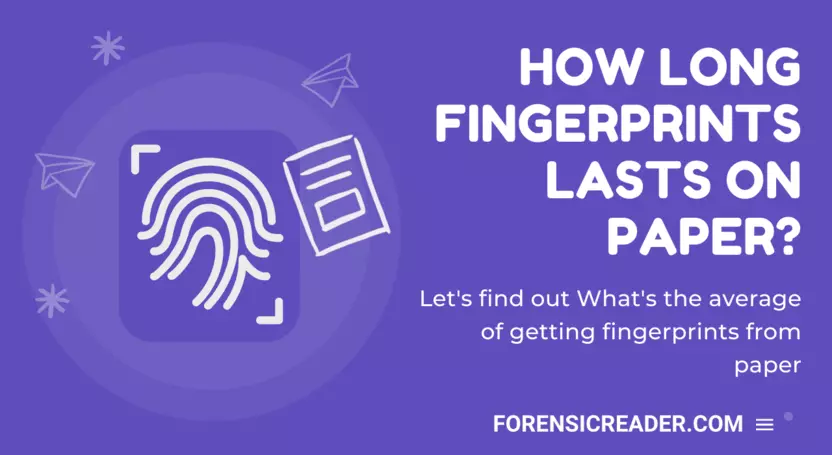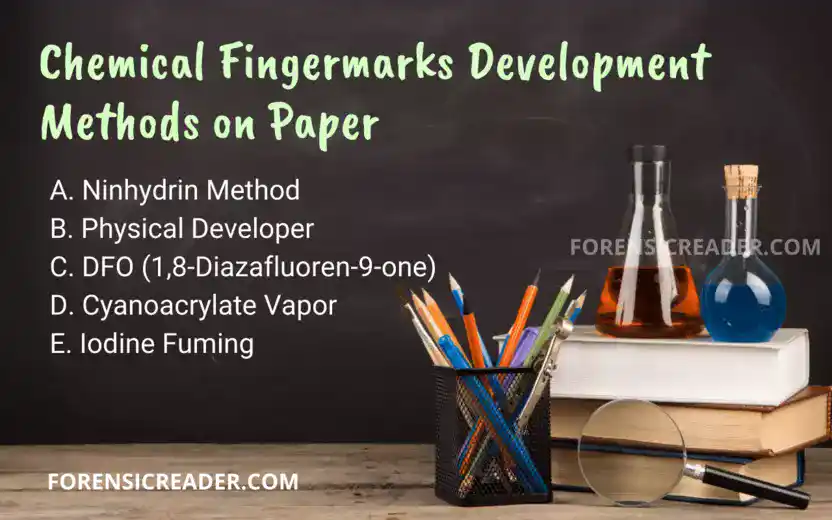The most recommended methods of developing fingerprints on paper are chemical methods followed by powdered methods.
With recent advancements, two novel techniques, alternative light, and laser light can also be used to detect fingermarks on papered questioned documents.
In this short post, I am going to list common methods on how you can develop fingerprints on paper.
How Long Fingerprints Lasts on Paper?

Researchers have developed prints older than 40+ years. With proper development techniques, fingerprints can be developed from 7 to 40+ years. This all depends on the paper’s surface ability to absorb the finger residue.
Higher the absorption longer the print stayed over the paper surface.
Thus, if it is glossy paper, the fingerprints are less absorbed leading to early destruction while normal paper absorbs fats, amino acids, and lipids from fingermarks resulting in nearly permanent latent marking on paper.
That’s why glossy paper has less (about 7 years) longevity of prints than regular paper. Read More: Forensic Analysis of Paper: An Informative Guide to Paper Forensic
Destructive and Nondestructive Techniques of Developing Fingerprint on Paper
Following are some-to-all techniques that are used to extract fingerprints from paper that is being questioned.
- Optical Examination
- Alternative light Source
- Laser light Source
- Chemical methods
- Ninhydrin
- Physical Developer
- DFO
- Cyanoacrylate Vapor
- Iodine Fuming
- Powder Methods
- Electrostatic Detection Apparatus
- Small Particle Reagent (SPR)
These same techniques can be employed to develop any type of paper substrate that is usually encountered by the Forensic Document Unit (FDU).
Remember Rule of Thumb: If the paper is needed to process for both fingerprint and handwriting/printing/typewritten examination, then papered evidence first goes through the forensic questioned document examination followed by fingerprint development. Know more: Which One should be Preferred: Fingerprint or Questioned Documents? And Why?
1. Non-Destructive Optical Fingerprint Enhancement
Optical examinations are quick and non-destructive ways of getting fingerprints from a questioned document. It includes alternative light, laser light, and photocopying methods.
A. Alternative Light Sources
Alternative light illumination gives a brief spectrum mainly for infrared and ultraviolet examination that sometimes reveal fingerprints majorly when:
- prints have traces of biological fluids such as saliva, blood, etc.
- prints are fresh.
An alternative light examination should be conducted on every paper as a pre-examination, before jumping to the development phase. And, if latent prints become visible, they should be photographed using appropriate filters.
B. Argon Laser Light
It could be included in alternative light illumination because, in a way, argon laser light falls in the electromagnetic spectrum.
It is most extensively used for detecting fingerprints on hard papered substrates like cardboard. Argon laser examination can also reveal erased markings on QDs.
The process simply involves, the exposure of papered documents to argon laser light that fluoresces fingerprint residue. If prints are visible, they should be photographed.
The best setting for getting fluorescence with an argon laser:
- Wavelength: between 488 nm or 514.5 nm
- Filters: Wratten filters 15 and 22.
C. Photocopying Methods
Photocopying methods can make latent prints contrast.
The principle behind this is; photocopying in darker settings makes the scanner more spectral sensitive that can trace down the weaker details and further print them.
Not recommended for fresh prints on paper or fingermarks on glossy paper. Fresh prints on paper can transfer to the glass platen of the printer.
2. Chemical Development Methods
The most common chemical development techniques are ninhydrin, physical developer, DFO, cyanoacrylate vapors, and iodine fuming. They are destructive in nature and create a visible strain on paper, except iodine fuming.

A. Ninhydrin Method
- Color: Purple (Ruhemann’s purple)
- A most common method for developing latent prints on paper.
- Ninhydrin reacts with amino acids of fingermarks.
- Effective even on old prints.
- Easily be made in the laboratory (ninhydrin with ethyl alcohol), or easy to buy commercially.
- Stains too much and can obliterate writing, printed or typewritten document features.
B. Physical Developer
- Color: dark grey or black
- Silver-based aqueous reagent.
- Reacts with salts, fats, and lipids in fingermark residue.
- Use when ninhydrin fails to develop prints.
C. DFO (1,8-Diazafluoren-9-one)
- Color: pale pinkish-purple product not visible that glow under blue-green light.
- Reacts with amino acid components of fingermarks.
- Stain less than ninhydrin
- Requires expensive chemicals and equipment.
D. Cyanoacrylate Vapor
- Other names: Ethyl cyanoacrylate vapor, Superglue
- Paper is subjected to an air-tight chamber and exposed to ethyl cyanoacrylate vapor that adheres to fingermarks.
- Best result at 80% humidity and cyanoacrylate heated to 120°C.
E. Iodine Fuming
- Color: dark yellow to brown
- Inexpensive and produce temporary shades.
- A questioned document is placed in a chamber and exposed to iodine fumes that react with fatty acid.
- Photograph as soon as print develops.
- Can be used for covert examination
- Best for developing prints on thermal or carbonless paper.
- Hazardous, if vapors are inhaled.
3. Powder Methods
For the development of fingerprints on porous surfaces like paper, the powder method is not recommended.
But why? Because (1) they are insensitive to old prints, (2) they have detrimental effects on the development of indented writing marks, (3) most powders are soluble in fluids such as humidity and perspiration that may be found on documents.
So, they are never be used? No, there are some instances where powder methods can be employed. These involve:
- Glossy paper (except magnetic powder, they are less sensitive).
- Recently made prints like from suspects for comparison.
- Paper with no writing, print, or signatures.
- For dark or multicolored paper (anthracene and photograph in UV)
4. Electrostatic Detection Apparatus (ESDA)
ESDA is not only helpful in revealing the indentation marks on questioned documents but can develop fingerprints that are freshly registered.
Old prints can’t be detected using this method because they don’t produce any dielectric difference from paper.
5. Small Particle Reagent (SPR)
It is highly unlikely to have a situation to have questioned documents (glossy) submerged in water.
But if it does, the examiner can develop the fingerprint using small particle reagents (or dry them and use any regular chemical technique).
Introducing SPR, it is a wet powdering technique that has surfactant which forms stable micelles around the particles (Molybdenum Disulfide) in water and settles over the non-soluble constituents such as fatty acids of fingermarks.
This results in fingerprint development even when the glossy/coated questioned document is submerged in water.
General FAQ
Can you get fingerprints from paper?
Yes, using various means such as chemical, powder, electrostatic, and laser, you can easily get a fingerprint developed. Moreover, developing techniques majorly depends on paper substrate eg: chemical is best for normal paper, the powder is best for glossy paper, and so on.
Why is the powder method not recommended for fingermarks on questioned documents?
Because they are insensitive to older finger marks and cause detrimental effects on indentation writing that were present on questioned documents. Plus, they are soluble in humidity which is the characteristic of paper.
What was the old way of getting fingerprints from paper?
Chemical measures such as ninhydrin, DFO, and iodine fuming are the old ways of getting fingerprints from paper. New techniques use laser, alternative light, or electrostatic optical examinations of prints on paper.
What fingerprint method is best for paper?
Chemical methods such as ninhydrin (more stain), DFO (less stain), and iodine fuming (temporary stain) are some of the best development techniques for developing fingerprints over the paper.
Is it legal to remove fingerprints from paper?
Tampering evidence is also an offense whether or not your prints were on questioned documents. So, it is not legal to destroy or alter the forensic questioned document by any means. Doing so can lead you to lawsuits.
References:
- Methods of latent fingerprint development [source]
- Advances in fingerprint technology [book]
- Lee and Gaensslen’s advances in fingerprint technology [book]
- Forensic Document Examination: Principles And Practice [book]
- Observations on paper as evidence [book]
- Use of physical developer for the visualization of latent fingerprints [source]
Continue Reading:
- Legal Obligation of Person’s Fingerprints Over Questioned Documents
- Is it possible to remove a fingerprint from paper?
- Can Fingerprints be Lifted from Paper?
- 14 Myths of Fingerprints And Questioned Documents: A Forensic Study

FR Author Group at ForensicReader is a team of Forensic experts and scholars having B.Sc, M.Sc, or Doctorate( Ph.D.) degrees in Forensic Science. We published on topics on fingerprints, questioned documents, forensic medicine, toxicology, physical evidence, and related case studies. Know More.
